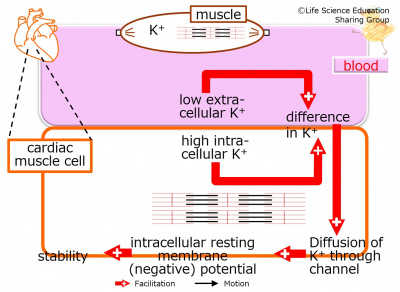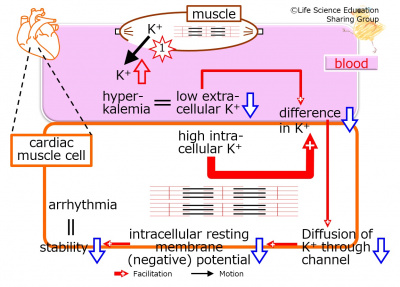「Nervous system/overview of neurons/Crush syndrome/effect of hyperkalemia on cardiac muscle」の版間の差分
編集の要約なし |
編集の要約なし |
||
| (同じ利用者による、間の7版が非表示) | |||
| 1行目: | 1行目: | ||
{{Point|When a muscle is crushed, K<sup>+</sup> in blood is increased, and in cardiac muscle cells, diffusion of K<sup>+</sup> through K<sup>+</sup> channel is less, resting membrane potential is less, stability of the cell is less, causing arrythmia.}} | {{Point|When a muscle is crushed, K<sup>+</sup> in blood is increased, and in cardiac muscle cells, diffusion of K<sup>+</sup> through K<sup>+</sup> channel is less, resting membrane potential is less, stability of the cell is less, causing arrythmia.}} | ||
[[メディア:Crush syndrome en.mp4|narrated animation]] | |||
[[ファイル: | [[ファイル:CrushSyndromeEn-1.jpg|left|400px]] | ||
Both the high intra-cellular potassium (K<sup>+</sup>) and low extra-cellular potassium (K<sup>+</sup>) bring about the difference, which is the driving force of the diffusion of potassium ion (K<sup>+</sup>) through channel. | |||
With more diffusion, the intracellular resting membrane negative potential increases, and with more intracellular resting membrane potential, the cell becomes more stable. | |||
<br style="clear:both;" /> | |||
[[ファイル:CrushSyndromeEn-2.jpg|left|400px]] When the legs are compressed for a long time, such as in earthquake-destroyed buildings, a muscle is crushed, potassium (K<sup>+</sup>) is released and then increased in the blood. Hyperkalemia means extracellular potassium is NOT as low, which also means that the difference between extra- and intra- cellular potassium (K<sup>+</sup>) is less. | |||
There will be less diffusion of K<sup>+</sup> through the K<sup>+</sup> channel, resting membrane potential decreases, and the stability of the cardiac muscle cell decreases, causing arrhythmia. | |||
<br style="clear:both;" /> | |||
When the legs are compressed for a long time, such as in earthquake-destroyed buildings, a muscle is crushed, potassium (K+) is released and then increased in the blood. Hyperkalemia means extracellular potassium is NOT as low, which also means that the difference between extra- and intra- cellular potassium (K+) is less. | |||
There will be less diffusion of K+ through the K+ channel, resting membrane potential decreases, and the stability of the cardiac muscle cell | |||
{{QuizTitle}} | {{QuizTitle}} | ||
| 14行目: | 14行目: | ||
//LEVEL:3 | //LEVEL:3 | ||
//RAND | //RAND | ||
When a muscle is crushed, K<sup>+</sup> in blood is {=increased | When a muscle is crushed, K<sup>+</sup> in blood is {=increased~decreased}, and in cardiac muscle cells, diffusion of K<sup>+</sup> through K<sup>+</sup> channel is {=less~more}, resting membrane potential is {=less~more}, stability of the cell is {=less~more}, causing arrythmia. | ||
</ | </GIFT> | ||
2017年2月21日 (火) 12:35時点における最新版
| When a muscle is crushed, K+ in blood is increased, and in cardiac muscle cells, diffusion of K+ through K+ channel is less, resting membrane potential is less, stability of the cell is less, causing arrythmia. |
Both the high intra-cellular potassium (K+) and low extra-cellular potassium (K+) bring about the difference, which is the driving force of the diffusion of potassium ion (K+) through channel.
With more diffusion, the intracellular resting membrane negative potential increases, and with more intracellular resting membrane potential, the cell becomes more stable.
When the legs are compressed for a long time, such as in earthquake-destroyed buildings, a muscle is crushed, potassium (K+) is released and then increased in the blood. Hyperkalemia means extracellular potassium is NOT as low, which also means that the difference between extra- and intra- cellular potassium (K+) is less.
There will be less diffusion of K+ through the K+ channel, resting membrane potential decreases, and the stability of the cardiac muscle cell decreases, causing arrhythmia.
Challenge Quiz
When a muscle is crushed, K+ in blood is increased decreased , and in cardiac muscle cells, diffusion of K+ through K+ channel is less more , resting membrane potential is less more , stability of the cell is less more , causing arrythmia.


